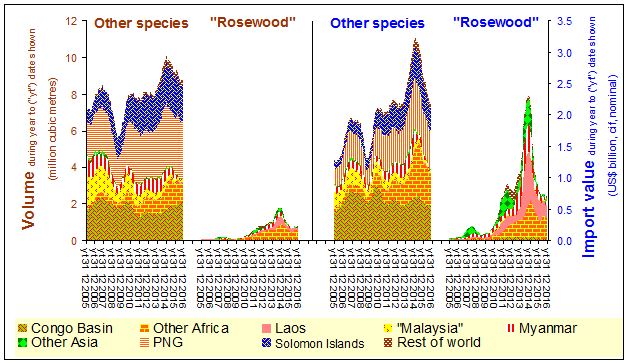|
|
||
|
|
||
|
China's imports of tropical logs
(highlighting "rosewood")
|
||
|
|
||
|
Reflecting the stature of its carved wood furnishing market, China reports trade in logs of a number of species - predomiantly of the Dalbergia (rosewood), Diospyros (ebony) and Pterocarpus (sandalwood ) families - under a unique commodity code (44039930) and describes this group as either "rosewood" or "padauk". As indicated in the lowermost of the three charts above, China's imports under this commodity code tended to vary between 50,000 and 100,000 cubic metres until 2010, when they started rising very rapidly (increasing sixfold in two years). The surge in imports during 2007 (mainly from "Vietnam" - much of which probably originated in neighbouring countries) shown in the upper pair of charts might have continued if the grossly unsustainable, credit-fuelled global economic bubble of the previous several years had not then deflated temporarily. If China respects its obligations as a signatory of CITES, the volumes of rosewood being imported into China from some countries would decline steeply from mid-June 2013, if as likely, the volumes being imported from those countries exceeds the maximum which could be sustained without detriment to the species' population. This is because a number of rosewood, ebony and sandalwood species were listed in Appendix II of CITES - with "annotations" which mandate controls on trade in logs, sawn wood, and certain other products, depending on annotation - and the listing came into effect on 12 June 2013. If, like most major consuming countries, China required that those who place wood-based products on its market carry out due diligence to minimise the risk that those products derive wholly or partly from illegal wood, then almost none of that rosewood would be deemed acceptable. This would help preserve the investment value of "rosewood" furnishings - particularly if supplemented by a credible licensing system within China designed to distinguish genuine rosewood from fraudulent products. (Such a system would help minimise exasperation with the authorities). Appealing to the market in the same way as has been tried by those campaigning against trade in ivory, tigers, sharks fin, animal parts etc is, for similar reasons, unlikely to have singificant impact. China's ivory consumption (illegal and supposedly legal)[EIA] has risen sharply during the last couple of years[BBC] - reflecting a fashion for gratuitous consumption of exotic products incompatible with sustainability and probably involving (criminal) supply chains similar to that for "rosewood". The style of this carved furnishing - imitating designs fashionable for the rich during the Qing and Ming dynasties - tends to reflect a yearning or preference for the imperial era (an argument which one might try to use when seeking the support of those now in power to reduce China's imports of rosewood to levels which are ecologically sustainable in each range state). Much of this is unlikely to suit the taste of markets outside China - other than within the expanding diaspora. In so far as furniture and ornaments account for a large majority of the "rosewood" which is supplied to China, most of that rosewood is likely to enter end-use there. However, it seems that substantial quantities are being exported as furniture[-], ornaments and musical instruments (including parts thereof). Almost all of those exports are probably illegal and most are likely to have been made in a small number of high profile localities - for example Dachong[-][60% market share] / Zhongshan and Dongyang (furniture), Huizhou[guitar parts imitating Taylor and Martin brands][-], Taixing (stringed instruments)[-] and Jiangyin [wind instruments]. There appears to be government support for the rosewood industry.[-] At least some of those supplies appear to be marketed in the USA[Chicago], which prohibits illegal wood-based products. Given that the export of logs (other than from trees gown in plantations) is prohibited from a number of the countries from which China imports "rosewood" (and other) logs (particularly those in central America)[-], importers and the authorities in China would appear to be at least negligent if not directly and negatively interfering in the affairs of those countries.
|
||
|
Copyright
globaltimber.org.uk
|




